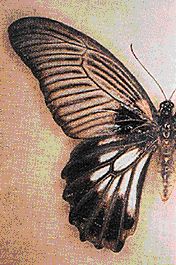Multi-locus population genetics - What is linkage disequilibrium?

What causes linkage disequilibrium?
Recombination breaks down non-random genetic associations, and yet in some cases non-random associations exist.
Four causes of linkage disequilibrium:
1. Natural selection. If selection favors individuals with particular combinations of alleles, then it produces linkage disequilibrium. It is this process that has most interested evolutionary biologists and is probably responsible for the Papilo memnon genes.
2. The linkage equilibrium has not yet been reached. It takes a number of generations for recombination to do its randomizing work and, particularly for tightly linked genes, linkage disequilibrium can persist for some time.
3. Random drift in a finite population. Random processes can cause persistent linkage disequilibrium. If random sampling produces by chance an excess of a haplotype in a generation, linkage disequilibrium will have arisen. Any haplotype could be 'favored' by chance, so the disequilibrium is equally likely to have D > 0 or D < 0. As a population approaches linkage equilibrium, all random fluctuations in haplotype frequencies will tend to be away from the linkage equilibrium values; if a population is well away from the point of linkage equilibrium, random sampling is equally likely to move it towards, as away from the equilibrium. Most natural populations are probably near linkage equilibrium and then the balance between the random creation of linkage disequilibrium and its destruction by recombination, in small enough populations, is such that linkage disequilibrium will persist.
4. Non-random mating. If individuals with gene A1 tend to mate with B1 types rather than B2 types, A1B1 haplotypes will have excess frequency over that for random mating.
The image opposite is of the rare anura form of Papilio memnon: : it is the recombinant which is similar to other forms, but lacks the tail.
The geneticist Linda Partridge clarifies the difference between linkage equilibrium and disequilibrium.
| Next |



